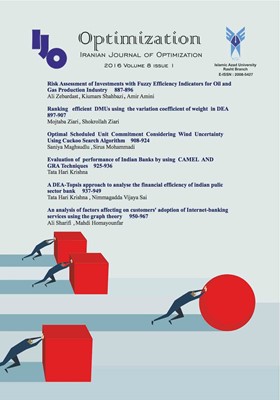ADEA-Topsis Approach to Analyse the Financial Efficiency of Indian Pulic Sector Bank
Subject Areas : Strategic ManagementHari Tata 1 * , Vijaya Nimmagadda 2
1 - Department of Mechanical Engg, V.R. Siddhartha Engineering College,Vijayawada, India
2 - Department of Mechanical Engg, V.R. Siddhartha Engineering College,Vijayawada, India
Keywords: Data envelopment analysis, TOPSIS, hybrid analysis, indian banking sector, financial efficiency, ,
Abstract :
In This paper a hybrid DEA method consisting of four phases for assigning the financial efficiency of commercial banks in India is used. This paper is based on panel data of banks for the period from 2011 to 2015. The DEA analysis based on hybrid method of DEA AND TOPSIS is used for ranking efficient Decision Making Units(DMUs) in Data Envelopment Analysis (DEA). However, since each of these methods considers a certain theory for ranking, there may exist different ranks. In practice, choosing a ranking method, the results of which the Decision Maker (DM) would be able to trust is an important issue.
Adel Hatami-Marbini et al. (2009). “An ideal-seeking fuzzy data envelopment analysis framework”. Elsevier Applied soft computing, 10 (10), 1062-1070.
Ali Kamil, T., & Ercan, S. (2006). “The Analytic Hierarchy & The Analytic Network Process in Multicriteria Decision Making: A Comparative Study”. Journal of Aeronautics and Space Technologies, 2 (4), 55-65.
Arora, S.; and Kaur, S. (2006). “Financial Performance of Indian Banking Sector in Post-Reform Era”.The Indian Journal of Commerce, 59(1), 96-105.
Bhattacharya, & Chakraborty. (2014). “A DEA-TOPSIS-based approach for performance evaluation of Indian Technical Institutes”. Decision science letters, 3 (3), 397-410
Bhayani, S. (2006). Performance of the New Indian Private Sector Banks: A Comparative Study. Journal of Management Research, 5(11), 53-70.
Bhutia, P. (2012). “Application of AHP & TOPSIS method for supplier selection problem”. IOSR Journal of Engineering, 2 (10), 43-50.
Bisht, N.S., Mishra, R.C., & Belwal, R. (2002). “Liberalisation and its Effects on Indian Banking”. Finance India, 16(1),147-152.
Bodla, B.S. & Verma, R. (2006). “Evaluating Performance of Banks through CAMEL Model: A Case Study of SBI and ICICI”. The ICFAI Journal of Bank Management, 5(3),49-63.
Brinda, J., & Dubey, A. K. (2007). “Performance of Public Sector Banks: An Econometric Analysis”. The Indian Banker, 2(12), 26-34.
Chandra, A. S., & Srivastava, M. (2008). “Scenario 2009: Are Indian Banks Ready?”. The Indian Banker, 3(1), 34-37.
Chaudhry, S., & Singh, S. (2012). “IMPACT OF REFORMS ON THE ASSET QUALITY IN INDIAN BANKING”. International Journal of Multidisciplinary Research, 2, 13-31.
Chaudhry,S.,& Singh,S. (2012). “IMPACT OF REFORMS ON THE ASSET QUALITY IN INDIAN BANKING ZENITH. International Journal of Multidisciplinary Research , 2 (1), January 2012.
Chen et al. (2013). “the Analysis of Bank Business performance and market risk- Applying Fuzzy DEA”. Elsevier- Economic Modelling, 32, 225-232.
Gopal, M., & Dev, S. (2006). “Productivity and Profitability of Select Public Sector and Private Sector Banks in India: An Empirical Analysis”. The ICFAI Journal of Bank Management,5(4), 59-67.
Gupta, R. (2008). “A CAMEL Model Analysis of Private Sector Banks in India”. Journal of Gyan Management, 2(1),3-8.
Iman Dabashi et al. (2013). “A Data Envelopment Analysis of Banks Performance in Iran”. International Research Journal of Applied and Basic Sciences,.4 (9),2422-2426.
Jing, J. (2012). “Fuzzy Evaluation on Supply Chains Overall Performance based on AHM & M (1,2,3). Jpurnal of Software, 7 (12), 2779-2786.
Karimzadeh, M. (2012). “Efficiency Analysisby using DEA model: Evidence from Indian Banks”. Int. J. Latest trends Fin.Eco.Sc , 2 (3), 228-237.
Kwan, S., & Eisenbeis, RA. (1997). “Bank risk, capitalization, and operating efficiency”. Journal of Financial Services Research ,12(2/3), 117-31.
Md kabir, A. (2012). “Performance Analysis through CAMEL Rating: A Comparative Study of Selected Private Commercial Banks in Bangladesh”.Journal Of Politics & Governance, 1 (2/3), 16-25.
Mishra Aswini Kumar, G., Harsha, H., Anand,SH.,& Dhruva,N.(2012). Analyzing Soundness in Indian Banking: A CAMEL Approach. Research Journal of Management Sciences, 1(3), 9-14.
Mishra Aswini Kumar, G., Sri Harsha, Sh.A., & Dhruva, N. (2012). “Analyzing Soundness in Indian Banking: A CAMEL Approach . Research Journal of Management Sciences, 1(3), 9-14.
Pathak, B. (2003). “A Comparison of the Financial Performance of Private Sector Banks”. Finance India, 17(4), 1345-1356.
Prasada, K.V.N., & Ravinder, G. (2012). A Camel Model Analysis of Nationalized Banks in India. International Journal of Trade and Commerce-IIARTC, 1(1), 23-33.
Prasuna, D.G. (2004). “Performance Snapshot 2003-04”. Chartered Financial Analyst, 3 (11),6-13.
Ram Mohan, T. T., & Ray, C. (2004). “Comparing Performance of Public and Private Sector Banks: A Revenue Maximization Efficiency Approach”. EPW,1271-1276.
Ramudu, J., & Rao, D. (2006). “A Fundamental Analysis of Indian Banking Industry”.The ICFAI Journal of Bank Management, 5(4), 68-79.
Rao, Suryachandra D. (2007). “Reforms in Indian Banking Sector: Evaluation Study of the Commercial Banks”. Finance India, 21(2), 591-597.
Ritika et al. (2014). “Application of DEA for performance evaluation of Indian Micro finance institutions”, Asian Journal of Management Research, vol 4 (3), 597-605.
Ruchi Gupta, CA. (2014). An Analysis of Indian Public Sector Banks Using Camel Approach. IOSR Journal of Business and Management (IOS-JBM), 16(1),94-102;
Sarker, A. (2005). “CAMEL Rating System in the Context of Islamic Banking: A Proposed „S‟ for Shariah Framework”. Journal of Islamic Economics and Finance,1 (1), 78-84.
Sekhar, S. D. (2007). “Trends in Growth and Development: Nationalised Banks in India”.The Indian Banker, 11(10), 28-32.
Venkata Subbaiah, K., & Narayana Rao, K. (2004). Supplier selection in Supply Chain Management through AHP, proceedings of VIII Annual International Conference. The Society of Operations Management, Mumbai, 72-80.
Vierstraete,V. (2012). “Efficiency in Human Development: a DEA”. The European Journal of Comparative Economics, 9 (3), 425-443.

